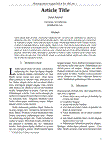Political institutions and tax rate initiatives
In a model of a representative democracy, we incorporate into the analysis of tax design the constitutional provision that allows voters to propose tax initiatives. In this paper, we present a theory of tax substitution as the rationale for a tax rate limit (TRL) initiative. In our model the tax sys...
| Autor principal: | |
|---|---|
| Formato: | Artículo |
| Lenguaje: | inglés |
| Publicado: |
Universidad Autónoma de Nuevo León
2009
|
| Materias: | |
| Acceso en línea: | https://ensayos.uanl.mx/index.php/ensayos/article/view/91 |
| Sumario: | In a model of a representative democracy, we incorporate into the analysis of tax design the constitutional provision that allows voters to propose tax initiatives. In this paper, we present a theory of tax substitution as the rationale for a tax rate limit (TRL) initiative. In our model the tax system at the status quo is determined by the electoral competition between parties. This political institution aggregates the voters’ preferences for tax policy according to the voters’ marginal proportion of the expected vote that different coalition of voters can deliver in the election. The approval of a TRL, however, depends on the majority rule, and it aggregates the preferences of the median voter of tax initiatives. Thus, a TRL is the result of two political institutions with different mechanisms to aggregate the preferences of voters. Moreover, our paper distinguishes the role of perfect and imperfect information on the distribution of voters´ preferences for tax systems in approving a tax initiative. In this paper we identify conditions on the distribution of preferences and income of the electorate and the median voter that guarantee the approval (rejection) of tax initiatives. Clasificación JEL: H2; H23; H1 |
|---|---|
| Descripción Física: | Ensayos Revista de Economía; Vol. 28 No. 2 (2009): NOVEMBER 2009; 65-94 Ensayos Revista de Economía; Vol. 28 Núm. 2 (2009): NOVIEMBRE 2009; 65-94 2448-8402 1870-221X |
